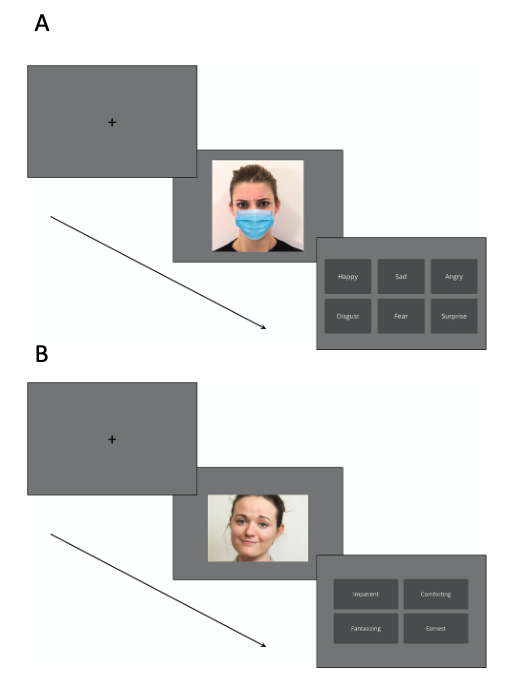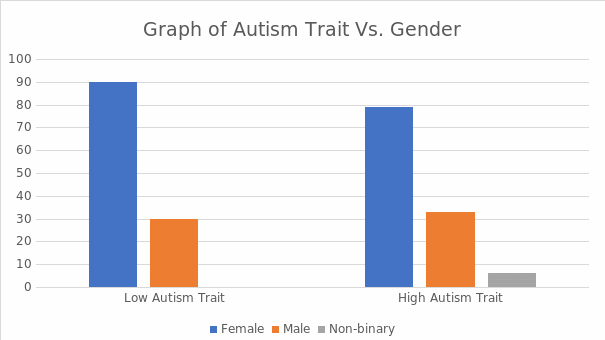Abstract
The study was to ascertain the association between autistic individuals and their capacity to comprehend facial emotion expression. The study recruited two Autistic Traits (AT) groups (N=397, 277 females, 111 males and 9 non-binary, Mean= 20.94, SD=4.18). They were required to complete an Autism Spectrum Quotient (AQ) questionnaire and do Face Emotion Recognition (FER) exercises. The group was asked to choose an emotion that matched the type of facial expression presented in order to assess their ability to recognize facial emotion expression. The results indicated that persons with high levels of autistic features had difficulty identifying the sort of facial expression represented by the faces presented to them. The AQ demonstrated reliability and validity by elucidating the number of autistic symptoms in persons of average intelligence. However, the FER tasks have significant limitations due to individuals’ practice of identifying facial emotion expressions, and hence provide less reliable information.
Methods
Participants
The participants involved in the research were undergraduate students recruited from the course. The initial sample of the students employed was 397 (277 females, 111 males, and 9 non-binary) who had a mean age of 20.94, ranging from 18-52, with a standard deviation (SD) of 4.18. The participants were then randomly sampled from the upper and lower quartiles of the distribution. A high Autism Trait (AT) and low AT groups were created by ranking the AQ scores of the participants, where the top third became the high AT group and the bottom third became the low AT group.
In the high AT group, there were 118 individuals (79 females, 33 males, and 6 non-binary), while in the low AT, there were 120 individuals (90 females, 30 males, and 0 non-binary). The mean AQ score for the whole sample was 18.57, with a SD of 6.68, where the low AT group had an AQ mean score of 11.79, while the high AT group had an AQ mean score of 25.75. Others were excluded from full participation on the basis of level of education, failure to wear masks, and long-time taken to complete a task.
Materials
The data used in this study was collected using the Autism Spectrum Quotient (ASQ) and the Facial Emotion Recognition tasks. The ASQ Assessment is an analytical questionnaire used to examine an individual’s subjective self-reported expression of autism-spectrum features (Flax et al., 2019). The QA scale was developed to ascertain the degree to which an individual with ordinary intelligence exhibits autistic-like symptoms. The test consists of fifty forced choice statements. To answer each question, participants must select one of four options: agree, slightly agree, slightly disagree, or disagree (Melina et al., 2022). Each marginally or definitively autistic answer earned the subject one point. The AQ demonstrated good test reliability as its measure is widely accepted, specified, and sensitive.
The FER tasks deployed were two, which included Basic Face Emotion Recognition (BFER) and Complex Face Emotion Recognition (CFER). The stimuli used for BFER were six basic expressions: happy, angry, disgusted, surprised, fearful, and sad. The images of ten actors, five males and five females, were shown once with no mask on and once again with a photo-shopped surgical mask. The trial sequence involved a fixation cross of 700 ms where participants are shown a random image in the middle of the screen for a duration, and they are expected to decide the category of the image from the six expressions provided, as illustrated in figure 1A. The stimuli used for the CFER were sixty complex expressions, including: comforting, earnest, impatient, and intrigued, as illustrated in figure 1B.

Procedure
Consent was obtained from the participants before participating in the research study group. Following that, a demographic survey was conducted to ascertain the number of participants, which was used to determine the size and quantity of materials required for the experiment (Bertrams and Schlegel, 2020). To avoid the order effect, the FER task was counterbalanced to minimize the effect of either fatigue or practice on the experiment’s results (West et al., 2020; Kadak et al., 2014). Prior to each FER task, the monitor stimuli were adjusted to produce a neutral white monitor with no color shift. This control was used to ensure that all participants saw the same image on the monitor under the same lighting conditions without any color shifting variation. Finally, people had to fill out an AQ questionnaire between each of the two FER tasks.
Results
The summary of the two groups statistics of low and high AT are presented in table 1 below.
Table 1: Summary of the statistics for the two groups of high and low AT
From the table 1 above, a graph of population of all gender against the type of autistic disorder was plotted as indicated in the diagram below (see Figure 2).

The above graph (see Figure 2) shows the number of males, females, and non-binary individuals with high and low autism traits. In two-tailed analysis of variance of AQ, there was a statistically significant change of emotional facial expression ((F (1, 40) = 1.541; p=.393; df = 2). The percentage of males with low autism traits is 8.90 % (30), while the percentage of females with low autism traits is 26.71% (90) (Mean=21.48, SD=-5.16 and mean AQ=11.79, SD for AQ=-2.6). Moreover, there was no non-binary individuals (n=0) with low autism traits. Conversely, the percentage of females with high autism traits is 23.44% (79), males with high autism traits is 9.79% (33), and non-binary with high autism traits is 1.78% (6 ) (mean =20.55, SD=-3.77, with mean AQ=25.75, SD for AQ=-4.48).
Discussion
From this study’s hypotheses, individuals with high autism traits tend to have lower facial emotion recognition as compared to people with low autism traits. In this regard, the possession of lower autism traits results in increased FER task accuracy (Baron-Cohen et al., 2001). Therefore, both the hypotheses are supported as shown in the diagram above (see Figure 2), which shows a statistically significant change in emotional facial expression on the variance of AQ.
The findings of this study have been supported by a study carried out by Kadak et al. (2014). Kadak et al.’s (2014) research is similar to this study in that ASD is associated with difficulty recognizing basic and complex facial expressions in individuals. The difference between the research conducted by Kadak et al. (2014) and this study is that this study established that the mask effect complicates facial processing for individuals with high levels of autistic traits, as the majority of facial expressions are imperceptible. This is because the masks cover most parts of the face, which are used to judge an individual’s emotions (Zhou et al., 2021). Alternative explanation for these findings is that humans express their facial expressions in response to their environment.
The limitation of this study is the bias of generalizability because the findings are used to represent the overall population. To combat this limitation in the future, the researcher should consider a larger sample size. For a new direction, the use of preclinical models of ASD can be used as they provide new insights about the relevant mediators of the neurobiological (Kulasinghe et al., 2021; Werneck-Rohrer et al., 2021). The methodology changes that might help overcome the above limitation include incorporating descriptive research design when interpreting the results and findings of the study.
Summary
Individuals possessing higher levels of autism traits tend to have low face emotion recognition accuracy for both complex and basic expressions, while those possessing lower autism traits have a higher FER accuracy. In this case, individuals in the high AT group had a low accuracy rate in identifying the facial expression, and the mask effect highly affected them too. The implication of this study is that it will contribute to a greater understanding of autism spectrum disorder in terms of how different levels of autistic traits affect an individual’s ability to identify facial emotion expressions. The Autism Quotient (AQ) is still a good and reliable way to check for autistic traits in people with average intelligence.
References
Baron-Cohen, S., Wheelwright, S., Skinner, R., Martin, J., & Clubley, E. (2001). The autism-spectrum quotient (AQ): Evidence from Asperger syndrome/high-functioning autism, males and females, scientists and mathematicians. Journal of Autism and Developmental Disorders, 31(1), 5–17.
Bertrams, A., & Schlegel, K. (2020). Speeded reasoning moderates the inverse relationship between autistic traits and emotion recognition. Autism, 24(8), 2304-2309.
Flax, J., Gwin, C., Wilson, S., Fradkin, Y., Buyske, S., & Brzustowicz, L. (2019). Social (pragmatic) communication disorder: Another name for the broad autism phenotype. Autism, 23(8), 1982-1992.
Kadak, M. T., Demirel, Ö. F., Yavuz, M., & Demir, T. (2014). Recognition of emotional facial expressions and broad autism phenotype in parents of children diagnosed with autistic spectrum disorder. Comprehensive Psychiatry, 55(5), 1146-1151.
Kulasinghe, K., Whittingham, K., & Mitchell, A. E. (2021). Mental health, broad autism phenotype and psychological inflexibility in mothers of young children with autism spectrum disorder in Australia: A cross-sectional survey. Autism, 25(5), 1187-1202.
Melina, J. W., Angwin, A. J., Copland, D. A., Arnott, W. L., & Nelson, N. L. (2022). Effects of emotional cues on novel word learning in typically developing children in relation to broader autism traits. Journal of Child Language, 49(3), 503-521.
Werneck-Rohrer, S., Lindorfer, T., Waleew, C., Philipp, J., Prillinger, K., & Konicar, L. (2021). Effects of an intensive slow cortical potential’s neuro-feedback training in female and male adolescents with autism spectrum disorder. Wiener Klinische Wochenschrift, 134(S1), 60-68.
West, M. J., Angwin, A. J., Copland, D. A., Arnott, W. L., & Nelson, N. L. (2020). Cross-modal emotion recognition and autism-like traits in typically developing children. Journal of Experimental Child Psychology, 191(1)s, 104737.
Zhou, M., Nasir, M., Farhat, L., Kook, M., Artukoglu, B., & Bloch, M. (2021). Meta-analysis: Pharmacologic Treatment of Restricted and Repetitive Behaviors in Autism Spectrum Disorders. Journal of the American Academy of Child & Adolescent Psychiatry, 60(1), 35-45.